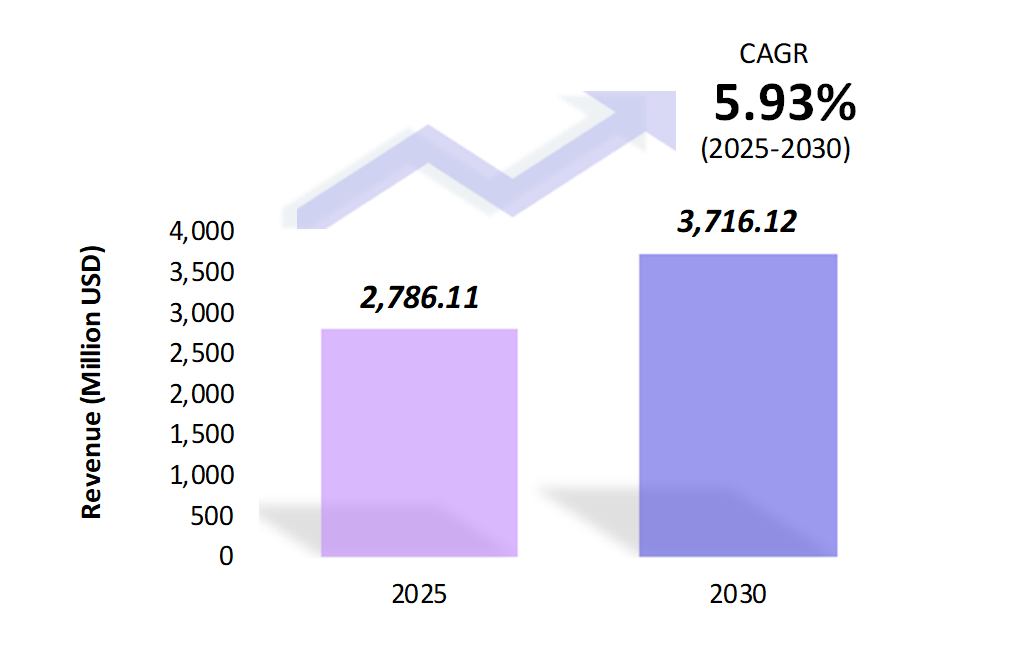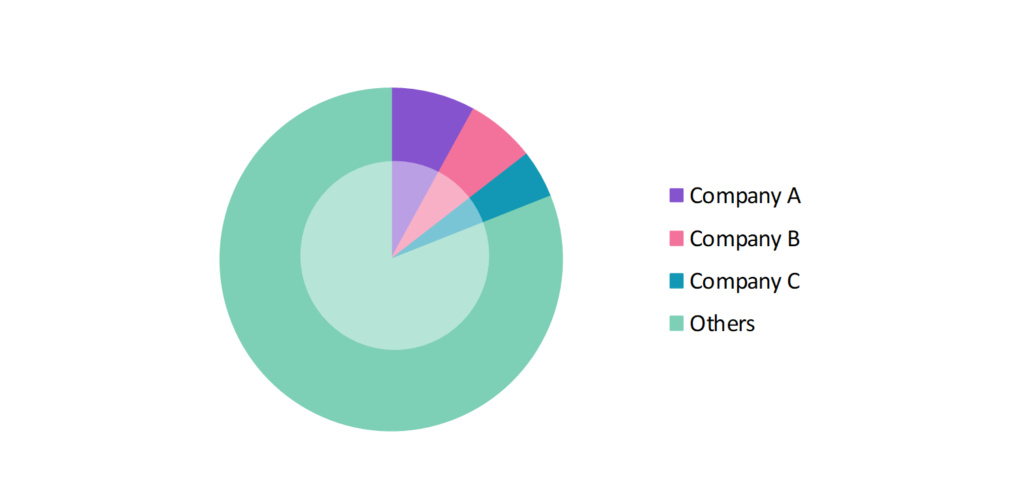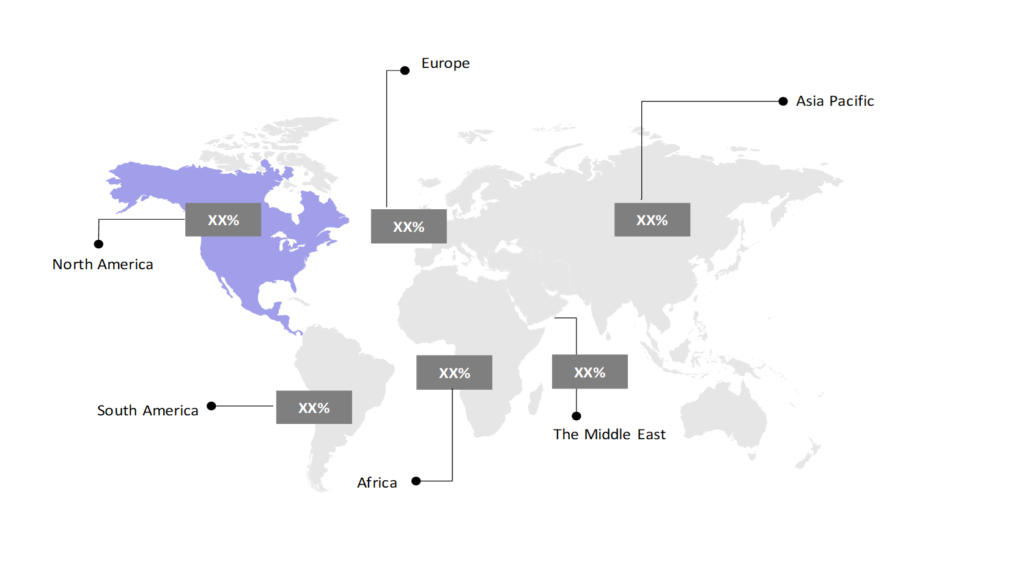Portable Ultrasound Device Market: Size, Share, Trends & Forecast (2024-2029)
The market report offers a detailed analysis segmented by Type of Device (Mobile Ultrasound Device, Handheld Ultrasound Device); by Application (Gynecology, Cardiovascular, Urology, Musculoskeletal, Anesthesiology, Others); by Geography (North America, South America, Asia Pacific, Europe, The Middle East, Africa).
Outlook

- The portable ultrasound device market is estimated to be at USD 2,786.11 Mn in 2025 and is anticipated to reach USD 3,716.12 Mn in 2030.
- The portable ultrasound device market is registering a CAGR of 5.93% during the forecast period 2025-2030.
- The global portable ultrasound devices market is witnessing robust growth, driven by rising demand for diagnostic tools in point-of-care (POC) settings, advancements in ultrasound technology, and the increasing prevalence of chronic diseases.
Request a free sample.
Ecosystem

- The participants in the global portable ultrasound device industry are always developing their strategies to preserve a competitive advantage.
- These companies primarily use acquisitions, investments, research & developments, partnerships, and technological launches.
- Several important entities in the portable ultrasound device market include Koninklijke Philips N.V.; Canon Inc.; Siemens AG; Fukuda Denshi Co., Ltd.; GE Healthcare; and others.
Ask for customization.
Findings
| Attributes | Values |
|---|---|
| Historical Period | 2019-2023 |
| Base Year | 2024 |
| Forecast Period | 2025-2030 |
| Market Size (2025) | USD 2,786.11 Mn |
| Market Size (2030) | USD 3,716.12 Mn |
| Growth Rate | 5.93% CAGR from 2025 to 2030 |
| Key Segments | Type of Device (Mobile Ultrasound Device, Handheld Ultrasound Device); Application (Gynecology, Cardiovascular, Urology, Musculoskeletal, Anesthesiology, Others); Geography (North America, South America, Asia Pacific, Europe, The Middle East, Africa) |
| Key Vendors | Koninklijke Philips N.V.; Canon Inc.; Siemens AG; Fukuda Denshi Co., Ltd.; GE Healthcare |
| Key Countries | The US; Canada; Mexico; Brazil; Argentina; Chile; China; Japan; South Korea; The UK; Germany; France; UAE; Saudi Arabia; Egypt; South Africa |
| Largest Market | North America |
Get a free quote.
Trends
- Advances in Wireless and Smartphone-Based Ultrasound Technology: Integration of wireless connectivity and smartphone compatibility is revolutionizing portable ultrasound, enhancing flexibility and usability. In 2022, Butterfly Network introduced the Butterfly iQ+, a handheld device that connects to smartphones, allowing real-time imaging and data sharing for medical professionals in remote settings.
- Increasing Adoption in Point-of-Care Diagnostics: Point-of-care applications are increasingly prominent, emphasized by the shift to portable ultrasounds that deliver immediate results. This trend enhances decision-making speed, particularly in emergency care and rural healthcare environments. As these technologies become more accessible, their role in providing timely diagnostics continues to evolve.
- Shift Towards AI-Driven Ultrasound Imaging: Artificial Intelligence integration enhances image quality and diagnostic accuracy, allowing for automated image interpretation and analytics. In 2022, GE Healthcare introduced its Vscan Air with AI-assisted imaging, streamlining ultrasound use in both urban and remote areas by offering automated guidance for non-specialists.
Speak to analyst.
Catalysts
- Increasing Prevalence of Chronic Diseases: Rising incidences of chronic conditions like cardiovascular diseases and cancers are driving demand for regular diagnostic imaging, which portable ultrasound devices can deliver conveniently in various settings. In 2022, the World Health Organization reported a global increase in cardiovascular diseases, boosting the need for accessible diagnostic tools.
- Rising Demand for POC and Remote Monitoring: Growing demand for point-of-care diagnostics in rural and remote locations has spurred the adoption of portable ultrasound devices. This is especially critical in disaster-stricken or low-resource areas where access to traditional imaging facilities is limited. For instance, in 2023, MSF (Doctors Without Borders) deployed portable ultrasound devices in emergency zones to facilitate on-the-spot diagnostics.
- Growing Focus on Cost-Effective Diagnostic Solutions: Portable ultrasounds offer a cost-effective alternative to traditional imaging modalities like Magnetic Resonance Imaging and Computed Tomography, which are not only expensive but also less accessible in remote areas. This makes portable ultrasound an attractive solution for budget-constrained healthcare facilities, particularly in developing regions.
Inquire before buying.
Restraints
- Limited Battery Life and Power Management Issues: Portable ultrasounds often face limitations related to battery life, impacting their usability in extended field operations. This has been a notable challenge, as seen in remote and disaster settings where reliable power sources are scarce, requiring manufacturers to focus on energy-efficient designs.
- High Initial Costs for Advanced Portable Ultrasounds: Advanced portable ultrasound devices with enhanced features, like AI integration and wireless capabilities, are often costly, limiting adoption among small clinics and rural healthcare providers. Despite their benefits, the high initial investment is a barrier, especially in emerging markets where healthcare budgets are constrained.
- Stringent Regulatory Approvals and Compliance: Portable ultrasound devices are subject to rigorous regulatory approvals, which can delay their market entry. In 2022, the Food and Drug Administration introduced more stringent guidelines for diagnostic ultrasound devices, requiring manufacturers to comply with updated safety standards, which can increase time-to-market for new products.
Personalize this research.
Hotspot

Explore purchase options.
Table of Contents
| 1. Introduction 1.1. Research Methodology 1.2. Scope of the Study 2. Market Overview / Executive Summary 2.1. Global Portable Ultrasound Device Market (2019 – 2023) 2.2. Global Portable Ultrasound Device Market (2024 – 2030) 3. Market Segmentation 3.1. Global Portable Ultrasound Device Market by Type of Device 3.1.1. Mobile Ultrasound Device 3.1.2. Handheld Ultrasound Device 3.2. Global Portable Ultrasound Device Market by Application 3.2.1. Gynecology 3.2.2. Cardiovascular 3.2.3. Urology 3.2.4. Musculoskeletal 3.2.5. Anesthesiology 3.2.6. Others 4. Regional Segmentation 4.1. North America 4.1.1. The US 4.1.2. Canada 4.1.3. Mexico 4.2. South America 4.2.1. Brazil 4.2.2. Argentina 4.2.3. Chile 4.2.4. Rest of South America 4.3. Asia Pacific 4.3.1. China 4.3.2. Japan 4.3.3. South Korea 4.3.4. Rest of Asia Pacific 4.4. Europe 4.4.1. The UK 4.4.2. Germany 4.4.3. France 4.4.4. Rest of Europe 4.5. The Middle East 4.5.1. UAE 4.5.2. Saudi Arabia 4.5.3. Rest of the Middle East 4.6. Africa 4.6.1. Egypt 4.6.2. South Africa 4.6.3. Rest of Africa 5. Value Chain Analysis of the Global Portable Ultrasound Device Market 6. Porter Five Forces Analysis 6.1. Threats of New Entrants 6.2. Threats of Substitutes 6.3. Bargaining Power of Buyers 6.4. Bargaining Power of Suppliers 6.5. Competition in the Industry 7. Trends, Drivers and Challenges Analysis 7.1. Market Trends 7.1.1. Market Trend 1 7.1.2. Market Trend 2 7.1.3. Market Trend 3 7.2. Market Drivers 7.2.1. Market Driver 1 7.2.2. Market Driver 2 7.2.3. Market Driver 3 7.3. Market Challenges 7.3.1. Market Challenge 1 7.3.2. Market Challenge 2 7.3.3. Market Challenge 3 8. Opportunities Analysis 8.1. Market Opportunity 1 8.2. Market Opportunity 2 8.3. Market Opportunity 3 9. Competitive Landscape 9.1. Koninklijke Philips N.V. 9.2. Canon Inc. 9.3. Siemens AG 9.4. Fukuda Denshi Co., Ltd. 9.5. GE Healthcare 9.6. Company 6 9.7. Company 7 9.8. Company 8 9.9. Company 9 9.10. Company 10 |
Know the research methodology.
Portable Ultrasound Device Market – FAQs
1. What is the current size of the portable ultrasound device market?
Ans. In 2025, the portable ultrasound device market size is USD 2,786.11 Mn.
2. Who are the major vendors in the portable ultrasound device market?
Ans. The major vendors in the portable ultrasound device market are Koninklijke Philips N.V.; Canon Inc.; Siemens AG; Fukuda Denshi Co., Ltd.; GE Healthcare.
3. Which segments are covered under the portable ultrasound device market segments analysis?
Ans. The portable ultrasound device market report offers in-depth insights into Type of Device, Application, and Geography.
